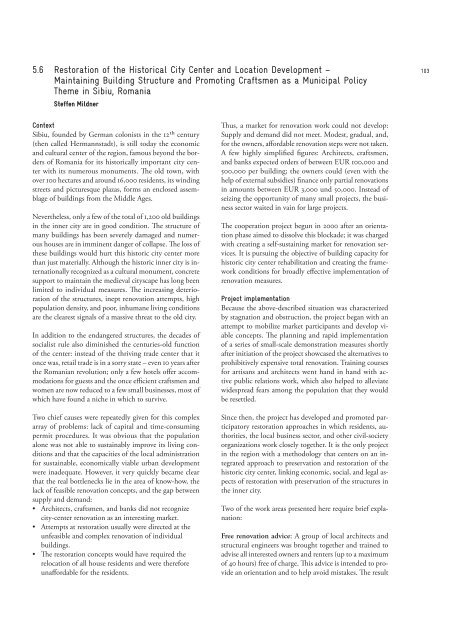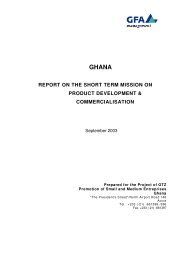Local/Regional Economic Development in South ... - Value Chains
Local/Regional Economic Development in South ... - Value Chains
Local/Regional Economic Development in South ... - Value Chains
Create successful ePaper yourself
Turn your PDF publications into a flip-book with our unique Google optimized e-Paper software.
5.6 Restoration of the Historical City Center and Location <strong>Development</strong> –<br />
Ma<strong>in</strong>ta<strong>in</strong><strong>in</strong>g Build<strong>in</strong>g Structure and Promot<strong>in</strong>g Craftsmen as a Municipal Policy<br />
Theme <strong>in</strong> Sibiu, Romania<br />
Steffen Mildner<br />
Context<br />
Sibiu, founded by German colonists <strong>in</strong> the 12th century<br />
(then called Hermannstadt), is still today the economic<br />
and cultural center of the region, famous beyond the borders<br />
of Romania for its historically important city center<br />
with its numerous monuments. The old town, with<br />
over 100 hectares and around 16,000 residents, its w<strong>in</strong>d<strong>in</strong>g<br />
streets and picturesque plazas, forms an enclosed assemblage<br />
of build<strong>in</strong>gs from the Middle Ages.<br />
Nevertheless, only a few of the total of 1,200 old build<strong>in</strong>gs<br />
<strong>in</strong> the <strong>in</strong>ner city are <strong>in</strong> good condition. The structure of<br />
many build<strong>in</strong>gs has been severely damaged and numerous<br />
houses are <strong>in</strong> imm<strong>in</strong>ent danger of collapse. The loss of<br />
these build<strong>in</strong>gs would hurt this historic city center more<br />
than just materially. Although the historic <strong>in</strong>ner city is <strong>in</strong>ternationally<br />
recognized as a cultural monument, concrete<br />
support to ma<strong>in</strong>ta<strong>in</strong> the medieval cityscape has long been<br />
limited to <strong>in</strong>dividual measures. The <strong>in</strong>creas<strong>in</strong>g deterioration<br />
of the structures, <strong>in</strong>ept renovation attempts, high<br />
population density, and poor, <strong>in</strong>humane liv<strong>in</strong>g conditions<br />
are the clearest signals of a massive threat to the old city.<br />
In addition to the endangered structures, the decades of<br />
socialist rule also dim<strong>in</strong>ished the centuries-old function<br />
of the center: <strong>in</strong>stead of the thriv<strong>in</strong>g trade center that it<br />
once was, retail trade is <strong>in</strong> a sorry state – even 10 years after<br />
the Romanian revolution; only a few hotels offer accommodations<br />
for guests and the once efficient craftsmen and<br />
women are now reduced to a few small bus<strong>in</strong>esses, most of<br />
which have found a niche <strong>in</strong> which to survive.<br />
Two chief causes were repeatedly given for this complex<br />
array of problems: lack of capital and time-consum<strong>in</strong>g<br />
permit procedures. It was obvious that the population<br />
alone was not able to susta<strong>in</strong>ably improve its liv<strong>in</strong>g conditions<br />
and that the capacities of the local adm<strong>in</strong>istration<br />
for susta<strong>in</strong>able, economically viable urban development<br />
were <strong>in</strong>adequate. However, it very quickly became clear<br />
that the real bottlenecks lie <strong>in</strong> the area of know-how, the<br />
lack of feasible renovation concepts, and the gap between<br />
supply and demand:<br />
• Architects, craftsmen, and banks did not recognize<br />
city-center renovation as an <strong>in</strong>terest<strong>in</strong>g market.<br />
• Attempts at restoration usually were directed at the<br />
unfeasible and complex renovation of <strong>in</strong>dividual<br />
build<strong>in</strong>gs.<br />
• The restoration concepts would have required the<br />
relocation of all house residents and were therefore<br />
unaffordable for the residents.<br />
Thus, a market for renovation work could not develop:<br />
Supply and demand did not meet. Modest, gradual, and,<br />
for the owners, affordable renovation steps were not taken.<br />
A few highly simplified figures: Architects, craftsmen,<br />
and banks expected orders of between EUR 100,000 and<br />
500,000 per build<strong>in</strong>g; the owners could (even with the<br />
help of external subsidies) f<strong>in</strong>ance only partial renovations<br />
<strong>in</strong> amounts between EUR 3,000 und 50,000. Instead of<br />
seiz<strong>in</strong>g the opportunity of many small projects, the bus<strong>in</strong>ess<br />
sector waited <strong>in</strong> va<strong>in</strong> for large projects.<br />
The cooperation project begun <strong>in</strong> 2000 after an orientation<br />
phase aimed to dissolve this blockade; it was charged<br />
with creat<strong>in</strong>g a self-susta<strong>in</strong><strong>in</strong>g market for renovation services.<br />
It is pursu<strong>in</strong>g the objective of build<strong>in</strong>g capacity for<br />
historic city center rehabilitation and creat<strong>in</strong>g the framework<br />
conditions for broadly effective implementation of<br />
renovation measures.<br />
Project implementation<br />
Because the above-described situation was characterized<br />
by stagnation and obstruction, the project began with an<br />
attempt to mobilize market participants and develop viable<br />
concepts. The plann<strong>in</strong>g and rapid implementation<br />
of a series of small-scale demonstration measures shortly<br />
after <strong>in</strong>itiation of the project showcased the alternatives to<br />
prohibitively expensive total renovation. Tra<strong>in</strong><strong>in</strong>g courses<br />
for artisans and architects went hand <strong>in</strong> hand with active<br />
public relations work, which also helped to alleviate<br />
widespread fears among the population that they would<br />
be resettled.<br />
S<strong>in</strong>ce then, the project has developed and promoted participatory<br />
restoration approaches <strong>in</strong> which residents, authorities,<br />
the local bus<strong>in</strong>ess sector, and other civil-society<br />
organizations work closely together. It is the only project<br />
<strong>in</strong> the region with a methodology that centers on an <strong>in</strong>tegrated<br />
approach to preservation and restoration of the<br />
historic city center, l<strong>in</strong>k<strong>in</strong>g economic, social, and legal aspects<br />
of restoration with preservation of the structures <strong>in</strong><br />
the <strong>in</strong>ner city.<br />
Two of the work areas presented here require brief explanation:<br />
Free renovation advice: A group of local architects and<br />
structural eng<strong>in</strong>eers was brought together and tra<strong>in</strong>ed to<br />
advise all <strong>in</strong>terested owners and renters (up to a maximum<br />
of 40 hours) free of charge. This advice is <strong>in</strong>tended to provide<br />
an orientation and to help avoid mistakes. The result<br />
103



